Are you looking to reduce your carbon footprint and create a more sustainable living space? In this article, we’ll guide you through the steps on how to make your house eco-friendly. By assessing your energy usage, implementing energy-efficient appliances, utilizing sustainable materials, incorporating renewable energy sources, and reducing water consumption, you can significantly decrease your environmental impact while saving money in the long run. Get ready to transform your home into an environmentally friendly haven!
Assessing Energy Usage
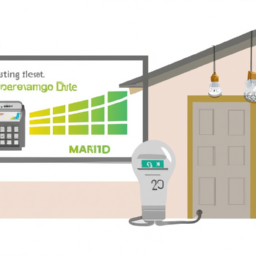
You can start assessing your energy usage by conducting an energy audit of your home. An energy audit is a thorough examination of your house to identify areas where you may be wasting energy and ways to improve efficiency. There are a few different ways you can conduct an energy audit, depending on your preferences and budget.
One option is to hire a professional auditor who will come to your home and perform a comprehensive assessment. They will use specialized tools and equipment to measure air leakage, insulation levels, and the efficiency of your heating and cooling systems. This type of audit provides the most accurate results but can be costly.
Another option is to do a DIY energy audit using smart home technology. Many smart devices, such as smart thermostats or energy monitoring systems, can help you track and analyze your energy usage in real-time. These devices provide valuable insights into how much electricity different appliances consume and when they are being used the most.
Implementing Energy-Efficient Appliances
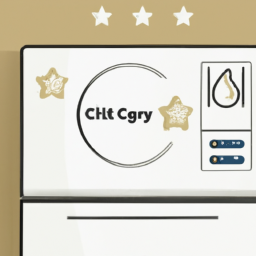
Implementing energy-efficient appliances can significantly reduce your household’s carbon footprint. By making the switch to energy-saving technology, you not only contribute to a greener environment but also save money on your utility bills. Smart home automation is a fantastic way to achieve this goal seamlessly.
Energy-saving technology refers to appliances that are designed with advanced features to minimize energy consumption. These appliances are built using innovative techniques and materials, allowing them to operate at maximum efficiency while using less electricity. From refrigerators and dishwashers to washing machines and air conditioners, there are energy-efficient options available for every appliance in your home.
One of the key benefits of smart home automation is its ability to optimize energy usage. With smart appliances, you have the power to control and monitor their operations remotely through your smartphone or voice-activated devices. This means you can adjust settings such as temperature, lighting, and water usage even when you’re away from home. Additionally, some smart appliances have sensors that automatically adjust their performance based on occupancy or ambient conditions.
When selecting energy-efficient appliances for your home, look for products with high Energy Star ratings. These ratings indicate that the appliance has been certified by an independent organization as meeting strict standards for energy efficiency. By investing in these appliances and embracing smart home automation, you can make a significant impact on reducing both your carbon footprint and monthly expenses.
Utilizing Sustainable Materials
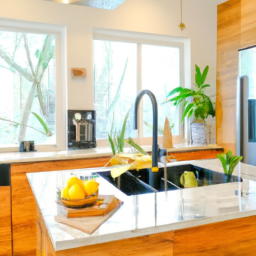
To incorporate sustainable materials into your home, consider using reclaimed wood for flooring and furniture. Reclaimed wood is a fantastic option for reducing waste and adding character to your living space.
When it comes to flooring, reclaimed wood offers a unique and rustic look that can’t be replicated by new materials. By repurposing old wooden planks, you not only reduce the demand for newly harvested trees but also prevent discarded wood from ending up in landfills. Look for suppliers who specialize in reclaimed wood and ensure that they source their products responsibly.
In addition to flooring, you can also incorporate reclaimed wood into your furniture. From dining tables to bookshelves, using this eco-friendly material adds warmth and charm to any room. Not only does it help reduce waste, but it also gives a second life to timber that might otherwise go unused.
Another important aspect of creating an eco-friendly home is choosing the right insulation material. Consider using eco-friendly options such as cellulose insulation or sheep’s wool insulation instead of traditional fiberglass batts. These alternatives are made from recycled materials or natural fibers, making them more sustainable choices.
Incorporating Renewable Energy Sources
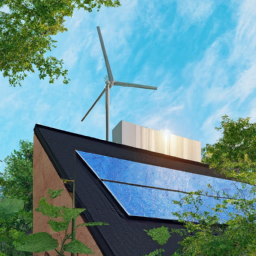
Using renewable energy sources like solar panels or wind turbines can greatly reduce your carbon footprint and provide sustainable power for your home. Solar power is a clean, abundant, and renewable source of energy that uses sunlight to generate electricity. Installing solar panels on the roof of your house allows you to harness this energy and convert it into usable power. By doing so, you not only reduce your reliance on fossil fuels but also save money on your utility bills in the long run.
Wind turbines, on the other hand, use the natural force of wind to generate electricity. These tall structures with rotating blades capture the kinetic energy of the wind and convert it into electrical energy. Although they require more space compared to solar panels, wind turbines are highly efficient in areas with consistent wind patterns.
To incorporate these renewable energy sources into your home, consult with professionals who specialize in installing solar panels or wind turbines. They will assess your property’s suitability for these systems based on factors such as sun exposure and average wind speeds.
Reducing Water Consumption
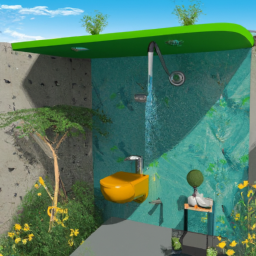
By conserving water through simple actions like fixing leaky faucets and using a low-flow showerhead, you can reduce your household’s water consumption and contribute to water conservation efforts. Another way to further reduce your water usage is by implementing rainwater harvesting techniques. Rainwater harvesting involves collecting and storing rainwater for later use. This can be done by installing rain barrels or cisterns that capture the rainwater from your roof gutters. The collected rainwater can then be used for various purposes such as watering plants, washing cars, or even flushing toilets.
In addition to rainwater harvesting, xeriscaping is another effective method to minimize water usage in landscaping. Xeriscaping refers to the practice of designing a garden or landscape that requires little to no irrigation. By selecting native plants that are adapted to the local climate and soil conditions, you can create a beautiful and sustainable landscape while reducing your reliance on supplemental watering.
To conserve even more water, consider making small changes in your daily habits. For example, turn off the faucet while brushing your teeth or shaving, as this can save gallons of water per day. Additionally, fix any leaks promptly as even a small drip can waste significant amounts of water over time.
Frequently Asked Questions
What Are Some Common Mistakes to Avoid When Assessing Energy Usage in Your House?
When assessing energy usage in your house, it’s important to avoid common mistakes that can hinder your efforts. One mistake is not conducting a thorough assessment of all energy-consuming appliances and devices. Another mistake is failing to properly insulate your home, leading to unnecessary energy loss. Additionally, overlooking small habits like leaving lights on or keeping electronics plugged in when not in use can add up over time. By avoiding these common mistakes, you can make your energy usage assessment more accurate and effective.
Are There Any Tax Incentives or Rebates Available for Implementing Energy-Efficient Appliances?
Tax incentives and rebates can be a great way to save money while making your home more energy efficient. When it comes to implementing energy-efficient appliances, there are often tax incentives available that can help offset the initial costs. These incentives vary depending on where you live and the specific appliance you’re looking to purchase. It’s important to research what incentives are available in your area and take advantage of them when upgrading your appliances for a more eco-friendly home.
How Can I Ensure That the Sustainable Materials I Use in My House Are Also Aesthetically Pleasing?
To ensure that the sustainable materials you use in your house are also aesthetically pleasing, consider several factors. Look for eco friendly materials that have a wide range of design options and finishes available. Research sustainable design principles and trends to find inspiration for incorporating these materials into your home’s overall aesthetic. Additionally, consult with interior designers or architects who specialize in sustainable design to get expert advice on how to create a visually appealing space using eco friendly materials.
What Are Some Innovative Ways to Incorporate Renewable Energy Sources Into a Small Urban House?
Looking to incorporate renewable energy sources in your small urban house? There are some innovative ways to do it! Consider installing solar panels on your rooftops for harnessing the power of the sun. You can also opt for wind turbines in your small garden, which can generate electricity from the wind. These methods not only help reduce your carbon footprint but also provide a sustainable source of energy for your home.
Besides Reducing Water Consumption, Are There Any Other Benefits to Installing Water-Saving Fixtures in My House?
Installing water-saving fixtures in your house has several benefits. Not only does it help in reducing water consumption, but it also saves you money on your water bills. Additionally, it contributes to conserving natural resources and protecting the environment. Apart from these advantages, incorporating smart meters can provide real-time data on your water usage, helping you monitor and manage it more efficiently. Rainwater harvesting is another eco-friendly practice that allows you to collect rainwater for various purposes like watering plants or flushing toilets while reducing strain on local water sources.
Conclusion
In conclusion, making your house eco-friendly is not only good for the environment but also for your wallet. By assessing your energy usage, implementing energy-efficient appliances, and utilizing sustainable materials, you can significantly reduce your carbon footprint and save on utility bills. Additionally, incorporating renewable energy sources such as solar panels or wind turbines can further decrease your reliance on fossil fuels. Lastly, reducing water consumption through low-flow fixtures and rainwater harvesting systems can help conserve this precious resource. With these practical steps, you can create a more sustainable and environmentally friendly home.